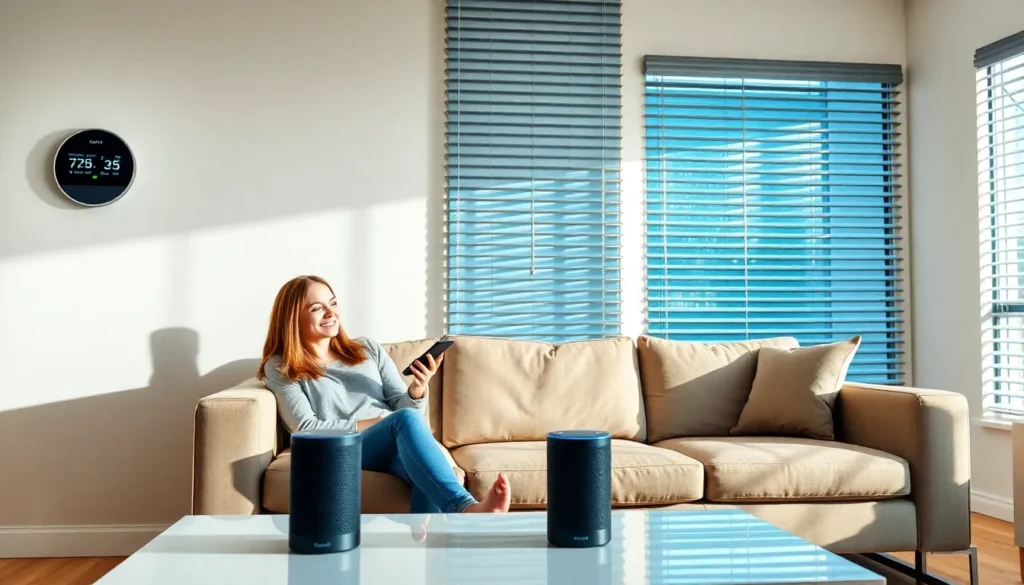Table of Contents
ToggleIn a world where smartphones reign supreme, the battle between Android and iPhone users is as fierce as ever. Picture this: you’re at a party, and your Android friend claims they can track your every move on their fancy device. Is it just bravado, or can Android really pinpoint an iPhone’s location?
Overview of Device Tracking
Device tracking utilizes GPS technology, Wi-Fi signals, and cellular networks to determine location. Android devices often employ Google’s location services, which aggregate data from various sources to pinpoint devices with high accuracy. iPhones, on the other hand, rely on Apple’s built-in features like Find My iPhone that operates similarly.
Users may wonder if an Android phone can track an iPhone location. Tracking is generally feasible if both devices use compatible applications and have location services enabled. Tracking applications available on both platforms can share user locations when permission is granted.
Several third-party applications, like Life360 or Glympse, enable cross-platform tracking by allowing users to share their location in real time. Each app functions based on user consent, making the user responsible for location-sharing decisions.
Moreover, privacy features on both Android and iOS limit unauthorized access to location data. Android’s permissions system requires explicit approval for apps to access location services. Similarly, iPhone users must enable location sharing through app settings, ensuring control over their private information.
Understanding how these systems work helps users navigate the complexities of location tracking. Consulting documentation from Google or Apple provides clarity on each platform’s tracking capabilities and privacy protocols. Engaging in responsible use of tracking features enhances security and privacy for all users involved.
How Location Tracking Works
Location tracking relies on several technologies to determine where a device is located. GPS technology, cellular networks, and Wi-Fi positioning each play distinct roles in the tracking process.
GPS Functionality
GPS functionality enables devices to determine their geographical location with high accuracy. Satellites transmit signals to devices, allowing them to calculate their position based on the time it takes for the signals to reach them. Android devices commonly utilize Google’s location services for GPS tracking. iPhones use a similar system integrated within iOS, ensuring users can access real-time location data. Accuracy often reaches within a few meters, making GPS a dependable choice for navigation and location sharing.
Cellular Networks
Cellular networks add another layer to location tracking. Devices connect to cell towers, which helps determine their approximate location based on signal strength and tower proximity. This method works well in urban areas with a high density of cell towers. While less precise than GPS, it provides a useful fallback when GPS signals are weak or unavailable. Android and iPhone users rely on their respective carriers for this service. Both systems ensure devices remain trackable even in challenging environments, like indoors or heavily obstructed areas.
Wi-Fi Positioning
Wi-Fi positioning complements GPS and cellular tracking by utilizing nearby Wi-Fi networks. Access points transmit signals that devices can use to triangulate their position. This method proves especially effective in urban settings and indoors, where GPS signals may falter. With many Wi-Fi networks available, tracking accuracy significantly improves. Both Android and iPhone users can benefit from this technique, enhancing their location-sharing capabilities. Additionally, Wi-Fi positioning often requires less power, making it an energy-efficient option for location tracking apps.
Android vs. iPhone Location Tracking
Location tracking capabilities differ between Android and iPhone devices, with permissions playing a crucial role in how each platform handles user location data.
Location Permissions on Android
Android devices maintain strict permission settings for apps accessing location services. Users must explicitly grant access, which helps protect personal information. The settings menu allows users to manage permissions for individual apps, offering transparency about which applications can track their location. Users can choose from options like ‘Allow all the time’, ‘Allow only while using the app’, or ‘Deny’ for enhanced privacy. Significant updates often improve location accuracy and user control, promoting responsible tracking practices. Android’s approach empowers users to take control of their location data while enabling necessary tracking features when desired.
Location Permissions on iPhone
iPhone location permissions also prioritize user privacy with secure settings. Each app requests permission, ensuring that users are informed before their location can be shared. Users can select from ‘Always’, ‘While Using the App’, or ‘Never’ to dictate tracking capabilities. The iPhone settings allow easy adjustments anytime, enabling users to revoke permissions if concerns arise. Implementing features like ‘Significant Locations’ helps users track frequently visited places without compromising overall privacy. Apple’s privacy-centric policies contribute to a secure environment while providing necessary location tracking functionalities.
Can Android Track iPhone Location?
Tracking an iPhone location using an Android device is feasible, given the right conditions are met. Both platforms utilize GPS, Wi-Fi, and cellular networks in tracking capabilities.
Methods of Tracking
Methods for tracking include specialized applications that bridge the gap between Android and iPhone. Life360 and Glympse enable cross-platform functionality contingent on users consenting to location sharing. GPS accuracy ranges within meters due to satellite signals, making it reliable. Cellular networks complement this by estimating locations based on cell tower proximity. Wi-Fi services enhance tracking indoors using nearby networks for triangulation. Users must ensure that location services are enabled on both devices for effective tracking.
Limitations and Challenges
Limitations exist in tracking due to privacy settings and permissions. Android and iOS systems enforce privacy features that restrict unauthorized access to location data. Users must grant explicit permission in both operating systems for applications to track their locations. Differences in how permissions are structured can complicate cross-platform tracking efforts. Additionally, inconsistent connectivity may affect the accuracy of tracking, particularly in remote areas. Potential users should remain aware of these challenges to ensure a smooth tracking experience.
Privacy Considerations
Privacy concerns are paramount when it comes to location tracking between Android and iPhone devices. Location services require explicit permissions, ensuring users retain control over their data. While tracking an iPhone from an Android device, both users must enable location services in their apps. This necessity for consent means that unauthorized tracking remains unlikely.
Both platforms feature robust privacy settings to protect user data. Android users can manage permissions for individual apps, allowing customization based on comfort levels. In contrast, iPhones require applications to formally request permission before accessing location information. This structure enhances user safety by preventing unwanted tracking.
Transparency plays a critical role in the tracking process. Users can easily view which apps access their location and revoke permissions anytime. Each platform emphasizes user responsibility in managing these permissions effectively.
Differences in these permission frameworks can complicate cross-platform tracking. Inconsistent connectivity can affect how accurately a device’s location is determined. Users should remain aware of environmental factors that may hinder GPS accuracy, such as urban landscapes or remote areas.
Ultimately, understanding the implications of location tracking is essential. Responsible users consider the balance between functionality and privacy. Both Android and iPhone users must actively manage their settings to ensure secure and consensual tracking experiences. Awareness of these privacy considerations leads to safer interactions between different devices.
The rivalry between Android and iPhone users extends to location tracking capabilities. While both platforms offer tools for tracking each other’s locations, user consent and privacy settings play crucial roles in the process. By utilizing compatible applications and ensuring location services are enabled, users can successfully share their whereabouts across devices.
However, it’s vital for users to remain vigilant about their privacy settings. Understanding how to manage permissions and recognizing the implications of location tracking can lead to safer interactions. As technology continues to evolve, staying informed will help users navigate the complexities of cross-platform tracking effectively.







